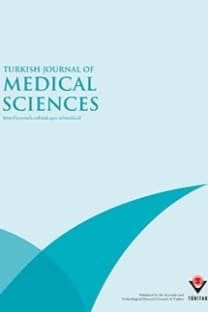Efficacy of convalescent plasma according to blood groups in COVID-19 patients
Efficacy of convalescent plasma according to blood groups in COVID-19 patients
___
- 1. Li Q, Guan X, Wu P, Wang X, Zhou L et al. Early transmission dynamics in Wuhan, China, of novel Coronavirus infected pneumonia. New England Journal of Medicine 2020; 382 (13): 1199-1207. doi: 10.1056/NEJMoa2001316
- 2. Zhu N, Zhang D, Wang W, Li X, Yang B et al. A novel Coronavirus from patients with pneumonia in China, 2019. New England Journal of Medicine 2020; 382 (8): 727-733. doi: 10.1056/NEJMoa2001017
- 3. Yeh KM, Chiueh TS, Siu LK, Lin JC, Chan PK et al. Experience of using convalescent plasma for severe acute respiratory syndrome among healthcare workers in a Taiwan hospital. Journal of Antimicrobial Chemotherapy 2005; 56 (5): 919-922. doi: 10.1093/jac/dki346
- 4. Ko JH, Seok H, Cho SY, Ha YE, Baek JY et al. Challenges of convalescen plasma infusion therapy in Middle East respiratory coronavirus infection: a single centre experience. Antiviral Therapy 2018; 23 (7): 617-622. doi: 10.3851/IMP3243
- 5. Wan Y, Shang J, Graham R, Baric RS, Li F. Receptor recognition by the novel coronavirus from Wuhan: an analysis based on decade-long structural studies of SARS coronavirus. Journal of Virology 2020; 94(7): e00127-20.doi:10.1128/JVI.00127-20
- 6. Walls AC, Park Y-J, Tortorici MA, Wall A, McGuire AT et al. Structure, function, and antigenicity of the SARS-CoV-2 spike glycoprotein. Cell 2020; 181(2): 281-292.e6. doi:10.1016/j. cell.2020.02.058
- 7. Lu R, Zhao X, Li J, Niu P, Yang B et al. Genomic characterisation and epidemiology of 2019 novel coronavirus: implications for virus origins and receptor binding. Lancet 2020;395(10224):565–574. doi:10.1016/S01406736(20)30251- 8
- 8. Guillon P, Clement M, Sebille V, Rivain JG, Chou CF et al. Inhibition of the interaction between the SARS-CoV spike protein and its cellular receptor by antihisto-blood group antibodies. Glycobiology 2008; 18(12): 1085-1093. doi:10.1093/ glycob/cwn093
- 9. Kumar S, Maurya VK, Prasad AK, Bhatt MLB, Saxena SK. Structural, glycosylation and 206 antigenic variation between 2019 novel coronavirus (2019-nCoV) and SARS coronavirus (SARS-CoV). Virus Disease 2020; 31(1): 13-21. doi:10.1007/ s13337-020-00571-5
- 10. Batool Z, Durrani SH, Tariq S. Association of ABO and Rh blood group types to hepatitis B, hepatitis C, Hiv And Syphilis infection, a five year’ experience in healthy blood donors in a tertiary care hospital. Journal of Ayub Medical College, Abbottabad 2017; 29 (1): 90-92.
- 11. Arendrup M, Hansen JE, Clausen H, Nielsen C, Mathiesen LR et al. Antibody to histo-blood group A antigen neutralizes HIV produced by lymphocytes from blood group A donors but not from blood group B or O donors. AIDS 1991; 5 (4): 441-444. doi: 10.1097/00002030-199104000-00014
- 12. Preece AF, Strahan KM, Devitt J, Yamamoto FF, Gustavson K. Expression of ABO or related antigenic carbohydrates on viral envelopes leads to neutralization in the presence of serum containing specific natural antibodies and complement. Blood 2002; 99 (7): 2477-2482. doi: 10.1182/blood.v99.7.2477
- 13. Cheng Y, Cheng G, Chui CH, Lau FY, Chan PK et al. ABO blood group and susceptibility to severe acute respiratory syndrome. The Journal of the American Medical Association 2005; 293 (12): 1450-1451. doi: 10.1001/jama.293.12.1450-c
- 14. Chen J, Subbarao K. The immunobiology of SARS. Annual Review of Immunology 2007; 25: 443-472. doi: 10.1146/ annurev.immunol.25.022106.141706
- 15. Gu J, Korteweg C. Pathology and pathogenesis of severe acute respiratory syndrome. American Journal of Pathology 2007; 170 (4): 1136-1147. doi: 10.2353/ajpath.2007.061088
- 16. Turk C, Turk S, Temirci ES, Malkan UY, Haznedaroglu İC. In vitro analysis of the renin-angiotensin system and inflammatory gene transcripts in human bronchial epithelial cells after infection with severe acute respiratory syndrome coronavirus. Journal of the Renin-Angiotensin-Aldosterone System 2020; 21 (2). doi: 10.1177/1470320320928872
- 17. Neil SJ, McKnight A, Gustafsson K, Weiss RA. HIV-1 incorporates ABO histo-blood group antigens that sensitize virions to complement-mediated inactivation. Blood 2005; 105 (12): 4693-4699. doi: 10.1182/blood-2004-11-4267
- 18. Li J, Wang X, Chen J, Cai Y, Deng A et al. Association between ABO blood groups and risk of SARS-CoV-2 pneumonia. British Journal of Haematology 2020; 190 (1): 24-27. doi: 10.1111/bjh.16797
- 19. Tendulkar AA, Jain PA, Velaye S. Antibody titers in Group O platelet donors. Asian Journal of Transfusion Science 2017; 11 (1): 22-27. doi: 10.4103/0973-6247.200765
- 20. De França NDG, Poli MCC, Ramos PGdA, Borsoi CSdR, Colella R. Titers of ABO antibodies in group O blood donors. Revista Brasileira de Hematologia e Hemoterapia 2011; 33 (4): 259-262. doi: 10.5581/1516-8484.20110073
- 21. Gill JC, Endres-Brooks J, Bauer PJ, Marks WJ Jr, Montgomery RR. The effect of ABO blood group on the diagnosis of von Willebrand disease. Blood 1987; 69 (6): 1691-1695.
- 22. O’Sullivan JM, Ward S, Fogarty H, O’Donnell JS. More on “association between ABO blood groups and risk of SARSCoV-2 pneumonia”. British Journal of Haematology 2020; 190 (1): 27-28. doi: 10.1111/bjh.16845
- 23. Focosi D. Anti-A isohemagglutinin titers and SARS-CoV2 neutralization: implications for children and convalescent plasma selection. British Journal of Haematology 2020; 190 (3): e148-e150. doi: 10.1111/bjh.16932
- ISSN: 1300-0144
- Yayın Aralığı: 6
- Yayıncı: TÜBİTAK
Fatih KÖSE, Gülşen DOĞAN DURDAĞ, Şafak YILMAZ BARAN, Seda YÜKSEL ŞİMŞEK, Songül ALEMDAROĞLU, Filiz AKA BOLAT, Hüsnü ÇELİK
Hepatitis A susceptibility parallels high COVID-19 mortality
Fatma Burcu BELEN, Kadir Mutlu HAYRAN, Faik SARIALİOĞLU
Efficacy of convalescent plasma according to blood groups in COVID-19 patients
Cenk SUNU, Yakup TOMAK, Mehmet KÖROĞLU, Oğuz KARABAY, Yasin KALPAKÇI, İlhan HACIBEKİROĞLU, Ahmet Cihad GENÇ, Tuba HACIBEKİROĞLU, Adem SARICAOĞLU
Does fludrocortisone treatment cause hypomagnesemia in children with primary adrenal insufficiency?
Gönül ÇATLI, Ayhan ABACI, Ahmet ANIK, Tolga ÜNÜVAR, İbrahim Mert ERBAŞ, Bayram ÖZHAN, Selda Ayça ALTINCIK
Hüseyin ÖZDEN, Erkan DULKADİROĞLU, Hüseyin DEMİRCİ
Eser SÖZMEN, Mehmet YALAZ, Özgün UYGUR, Özge ALTUN KÖROĞLU, Nilgün KÜLTÜRSAY, Yüksel ATAY, Mete AKISÜ, Ertürk LEVENT, Fırat ERGİN
Tansu SAV, Nevin İNCE, Kürşad ÖNEÇ, Mehmet Ali SUNGUR, Dilek MENEMENLİOĞLU
Şuayib YALÇIN, Gürkan GÜNER, Taha Koray ŞAHİN, Oktay Halit AKTEPE, Zafer ARIK
Bülent ÖZKURT, Tarık ÖZMEN, Salih Süha KOPARAL, Özlem KARATAŞ, Filiz ESER, Ümit GAFUROĞLU
Aygül TANTİK PAK, Alpay ALKAN, Yıldızhan ŞENGÜL, Hafize OTCU
